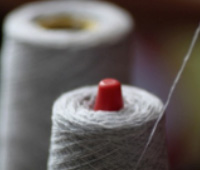The Development of Fire Retardant Fabrics

There is strong evidence that textile production dates back many thousands of years before the current era with the earliest examples evidenced in prehistoric finds in Africa and the Sub Continent.
Today the production of textiles is a global industry where the speed and volume of production has changed beyond all recognition thanks to modern manufacturing techniques.
There are many types of textile manufacturing processes such as plain weave, twill or satin weave. However, it is interesting to note that there is little difference between the ancient and modern methods apart from speed, the use of synthetic fibres, machinery, fabric blends and scale.
Early man used fibres from proteins and spun and plied thread like wool or hair and cellulose such as cotton into weaves that became rudimentary clothing, bedding and protective items.
The end uses of textiles today are multi faceted i.e. from clothing and household textiles items to construction and automotive ones.
Today woven and non-woven fabrics are used in carpeting, coverings, furnishings, fire retardant bedding and curtains, tickings and pocketing, window shades, towels art, headwear, roof insulation and tens of thousands more.
High Performance Textiles
Textiles used for industrial purposes or in a contract environment are commonly referred to as technical textiles or high performance textiles. In these industrial and commercial applications stringent performance requirements must be met. One sector of high performance textiles is Fire Retardant Textiles.
Fire Retardant Textiles
The use of fire retardant textiles in the contract sector has become increasingly important, so much so that laws have now been passed by Parliament stating what level of fire retardancy must be achieved in different environment, which are split into low, medium and high risk locations.
Examples of high risk would be a prison, a detention centre or an oil rig. Medium risk may be a psychiatric hospital or a nursing home and low risk would be holiday accommodation such as caravans and hotels etc.
Fabrics used in most public places such as Hospitals, Universities, Colleges, Schools, Churches, Theatres, Prisons, Detention Centres are required by law to be certified as flame retardant.
Fire Retardant Production
When looking at producing Fire Retardant fabrics, melting temperature is just one of the many factors to be considered. To meet a standard of flame retardancy a fabric must not ignite or create a self-sustaining flame when subjected to a heat source for a given passage of time. Most flame retardant compounds share common elements such as phosphorus, nitrogen and halogen. Transition, melting and combustion temperatures and the limiting oxygen index (LOI) must all be taken into consideration when determining the flame retardant factor.
Fire Retardant Certifications (FR)
Fire retardant fabric that is certified as FR has been treated in an immersion process with a chemical fire retardant after the fabric has been woven. All cottons and other natural fibres certified as flame retardant are FR treated. As the treatment is a chemical, it will leech out in time, and repeated cleaning will cause the flame retardancy to dissolve sooner. Most flame proofing chemicals are water soluble and will also dissipate through dry cleaning. For this reasons, “FR” flame retardancy is certified for a number of washes.
Inherently Fire Retardant (IFR) or Permanently Fire Retardant (PFR)
Fabric that has been certified as Inherently Fire Retardant (IFR) or Permanently Fire Retardant (PFR) has been woven from fibres that are intrinsically non-combustible. For this reason the fire retardancy of IFR and PFR fabrics will last for the life of the fabric and will not dissipate after cleaning.
Some polyester fabrics are considered permanently fire retardant. This is because fire retardant properties are built directly into the molecular structure of the fibres.
Other synthetic fabrics may be considered durably fire retardant, fire retardant or non-fire retardant.
Durably fire retardant refers to the process in which polyesters are chemically treated during the manufacturing process with non-water soluble chemicals. In other cases synthetic fabrics may be chemically treated after the manufacturing process or may be untreated and therefore be considered non-fire retardant.
Fire Retardant Fabrics Today
 Today, more than ever before, textiles receive a range of treatments prior to distribution. From formaldehyde finishes (to improve crease-resistance) to biocidic finishes and from flame retardants to dyeing of many types of fabric, the possibilities are almost endless.
Today, more than ever before, textiles receive a range of treatments prior to distribution. From formaldehyde finishes (to improve crease-resistance) to biocidic finishes and from flame retardants to dyeing of many types of fabric, the possibilities are almost endless.
However, many of these finishes may also have a detrimental side effect on the user. A number of dispense, acid and reactive dyes have been shown to be allergenic to sensitive individuals.
Flame retardant fabrics are also of concern where environmental concerns regarding their potential toxicity are at issue. Testing for these additives is possible at a number of commercial laboratories. It is also possible to test for compliance with the Oeko-Tex Certification Standard which contains levels for the use of certain chemicals in textiles products.
Latest Posts:
Thomas Kneale becomes Employee Owned!
Thomas Kneale & Co Limited is now owned by all of our colleagues through an Employee Ownership Trust (EOT). This exciting transition extends TK’s strong commitment to its colleagues, which includes its status as a Living Wage Foundation and Living Hours employer, and Gold Medal awarded by the EcoVadis Sustainability Platform. What does it mean […]
Diverse Owned Companies Perform Better
What is diversity and inclusivity? In simple terms the goal is to attract the very best talent available across the whole spectrum in society, hiring a diverse team, irrespective of gender, ethnicity, sexual orientation, race, religion, neuro diversity. Talent from all these categories can provide a company with its greatest asset, and we have found […]
Providing Our Team With The Skills
As a Living Wage Foundation employer and an active member of the Equality Register Thomas Kneale can fairly claim that our people are indeed our greatest asset. The TK team is well-resourced, seasoned and experienced, averaging a decade of service each, even more for most. We work with Aspire Recruitment, a not-for-profit enterprise who truly […]
Inaugural King’s Award Winner
Such an honour for us and a reward for our sustainability journey In the Summer of 2022, we decided to apply for the prestigious Queen’s Award for Enterprise. We felt we had a very persuasive and evidence-based case to justify our submissions in the Sustainable Development Category. In early 2023, the Award was renamed the […]



















